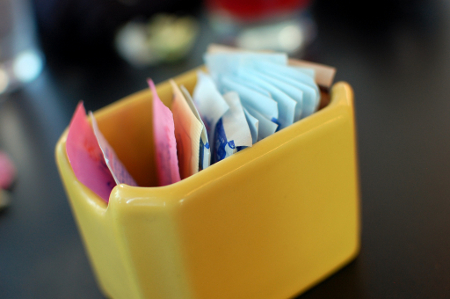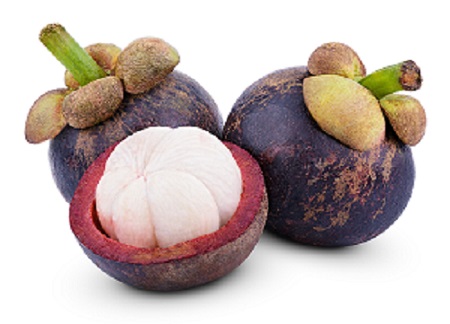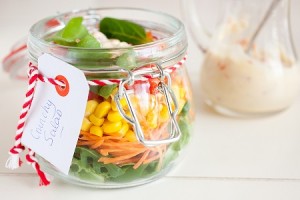Can’t live without sugar, cakes and sweets? Addicted to sodas? We can assume you haven’t yet heard about Dr. Robert Lustig, the American endocrinologist and childhood obesity specialist, considered the current nutrition prophet of doom.
Dr. Lustig declared war on sugar, blaming it for most of the western world’s modern disease, and his statements provoked a flurry of attention. Is this a tempest in a teacup, or should we really be afraid? And what role do artificial sweeteners play?
In a very provocative opinion column called “Sugar: The Bitter Truth”, published in February 2012 in the renowned scientific journal “Nature,” Dr. Lustig proclaimed sugar to be a poison, and that selling it should be regulated in the same manner as alcohol and cigarettes.

When Lustig talks about “sugar,” he primarily refers to “HFCS” – high fructose corn syrup “that since the 80’s is a main ingredient in food products such as cereals, sweet sodas, cereal snacks, cakes and cookies, sweets, alcoholic beverages etc.” Lustig calls it “The most evil supplement mankind has ever known”.
The article went viral in the American media, and Lustig’s claims made headlines, but that wasn’t the opening shot for his struggle. During July 2009, a 90 minute YouTube video was uploaded by Lustig on the subject, where the word “poison” in the context of sugar was mentioned 13 times.
To this day, the video has received more than 2 million views – an impressive number, considering the fact that we’re talking about a 90 minute discussion on the biochemistry of fructose and the human physiology. In April 2012, the New York Times dedicated a long article to Dr. Lustig’s “deadly” opinion regarding sugar.
No doubt about it, the buzz he created worked, but his provocative stance is winning a lot of criticism within the scientific community. His critics – and there are many – claim that the research testimonies Lustig presents aren’t enough.
“Just what we needed – another obsessive panic-creator obsessing with the sub kind of one nutrition ingredient instead of looking at the big picture,” blogs Allen Argon, a diet and exercise specialist, who also lectures in the national sports medicine academy and the American exercise council, among other places.
In the post published by the headline “Sugar Isn’t Evil: A Rebuttal”, Dr. Katz, head of the preventive research center in Yale University, claims that Lustig is talking nonsense.
Of course, nobody is disputing Dr. Lustig’s claim that high doses of sugar are bad for your health, but is it indeed the source of all evil in our diet and must we abstain from it completely? We checked to see what he’s saying and what other doctors and nutritionists are replying.
The increase in sugar intake is related to increase in illnesses?
Argument: The worrying increase in non-infectious chronic diseases, such as heart attacks, cancer, and diabetes specifically stem from the increase in sugar intake – particularly synthetically produced HFCS – which tripled around the world in the last 50 years.
What do other experts have to say: that the added sugar in our diet has indeed increased in the last decades, but the rates are a lot less than those indicated by Dr. Lustig. However, what has increased big time is our calorie intake.
According to the American agriculture report from 2009 examining nutritional consumption trends between 1970 and 2005, sugar and candy calorie consumption increased by 19% during those decades. But since 1999, there has actually been a decline of 9% in their consumption. Don’t be wrong, this isn’t enough to let out a sigh of relief yet.
According to the report, the average American consumes approximately 30 tablespoons of sugar over and above the sugars naturally existing in food, a very worrying piece of data. And yet, a 19% increase since 1970 is definitely not “thrice the amount of sugar”.
Opposite the calorie consumption of sugar and sweeteners, the report indicates a far more prominent increase in calorie consumption of wheat, flour, rice and grains (41%) alongside a 63% (!) increase in fat and oil consumption.
Different data in an earlier report by the American agriculture department from 2008 indicates that the calorie consumption average sum in 1970 was 2,172 calories, whereas in 2007 it reached 2,775 calories – meaning a total increase of 603 calories per day, which apparently landed somewhere in our collective fat cells.
Simultaneously, our lifestyles became more sedentary – research published in 2009 in the American Journal of Medicine found a decrease of 10% in exercise rates between 1988 and 2006. These two changes combined to enable the obesity plague and the increase in related illnesses more than sugar consumption.
“Pointing a finger at sugar is as stupid as it was pointing it at fat during the 80’s”, claims Allen Argon in his blog. “A quizzical eye over the data will indicate that the increase in obesity dimensions is mostly caused by the calorie consumption increase in general and lack of exercising, and not necessarily in the increase of blood sugar additives”.
Dr. David Katz writes in his blog, “Like most researchers, I don’t agree with Dr. Lustig’s shortsighted, militant focus on sugar abstinence. He’s missing the forest while barking at a single tree.”
Is sugar bad for you like alcohol and smoking?
Argument: Sugar isn’t just “empty calories” the way health authorities claim, but poison damaging our health just as alcohol and cigarettes do.
What do other experts have to say: like alcohol consumption, sugar consumption in moderate dosages and as part of a healthy diet isn’t dangerous, consumption in high dosages and as a part of a “junk food diet” can be damaging.
“With all due respect to Dr. Lustig, alcohol is not a nutrient,” explains Guy Salmon, clinical dietitian. “We don’t need alcohol to survive. On the other hand, sugar is required for us to survive. The glucose is in our blood, it’s an exclusive substance for the brain, and supplies energy to our muscles.”
According to endocrinologist Dr. Ram Weiss of the Department of Human Nutrition and Metabolism at the Hebrew University in Jerusalem, Israel, research conducted among children and adults showed that drinking one soft drink serving (200-250ml) per day over time doubles the chance of gaining weight. Drinking two servings per day quadruples the risk.
“The increased risk graph is steep. Our body isn’t born with the ability to digest soft drinks, and that’s the reason why half the sugar in it immediately turns into fat, and the other half left doesn’t make you feel full, because the brain doesn’t translates it as a digestive action. In this, Dr. Lustig is completely right, but the problem is that he takes this issue to extremes”.
Is fructose more dangerous than white sugar?
Argument: Fructose is more dangerous than white sugar because it can encourage liver toxicity and a variety of chronic diseases.
What do experts have to say: In higher dosages, fructose can lead to an infectious reaction in the liver.
“As opposed to white sugar, fructose doesn’t elevate the blood’s sugar levels, but it causes an increased formation of triglycerides (blood fats)”, explains Dr. Raz. “When they elevate, they tend to set in the liver and muscle tissues, for example, and make them turn fatty. The body responds to the situation as an infection and sends white blood cells that secrete materials called inflammatory cytokines. But the cytokines prevent the liver from recognizing the insulin, and it increases the blood production to compensate the false deficiency, and that’s how excess sugar is created. Indeed, the pancreas keeps creating more insulin in response to the excess sugar, but that isn’t enough to overcome the problem, and so a significant amount of fructose accumulates, which can be even more dangerous than excess glucose.”
It’s also important to differentiate between the kind of fructose – natural or processed. Fructose, also known as “fruit sugar,” is found in fruits and vegetables in its natural, unprocessed form, combined with other components such as dietary fibers, vitamins, minerals and antioxidants that benefit your health. But the HFCS rich in fructose added in large quantities to industrial food products is processed and has no nutritional value. And that makes all the difference.
Lustig’s demand to downsize HFC as much as possible is completely justifiable. According to the American agriculture department’s report from 2009 between the years 1970-2005 this sweetener’s availability has grown by 387% per person, at the expense of white sugar, whose use declined by 38%. The industries producing soft drinks, processed foods, and baked goods are the main uses of HFCS, because it’s cheap and sweeter than regular sugar.
This said, Dr. Katz warns us “not to throw the baby out with the water. A diet can contain fructose and be healthy. Even so, it can also be low on fructose, but rich in sodium or trans-fats or light in fiber and omega-3 type fats and be as far away from healthy as can be.” Therefore, the emphasis must be on the kind of fructose and its quantities.
The natural sweeteners challenge
So sugar isn’t poison, but if we consume large quantities of it, it can absolutely damage our health. If so, how can we on one hand downsize our sugar intake, yet on the other hand not forgo sweets completely? Indeed a difficult problem, especially in light of the fact that the main solution offered to us so far, artificial sweeteners, is itself known to be controversial.
The creative solution, which seems to be getting trendier, is natural sweeteners. The grocery store variety that used to hold the only alternatives – honey, molasses and maple syrup – has new players joining in: agave nectar, Stevia, sugar alcohols (i.e. xylitol, erythritol), and monkfruit
. Are these natural sweeteners in fact better than sugar and HFCS?
Guy Salmon explains that all of the traditional natural sweeteners contain large amounts of calories, similarly to sugar, and are based on sugar units, such as glucose, fructose, and sucrose. It’s true that if you consume them in their unprocessed form – whole honey, date honey, and real maple syrup (produced from a cedar tree, not the sugar imitation) – they contain some nutrients such as vitamins, minerals, and amino acids, but in large quantities, they can be harmful as well.
So what’s the bottom line?
“In the process of sweetening drinks, the natural sweeteners are preferable and better than the white sugar and corn syrup, but also need to be consumed in moderation”.
A sweetener based on the Stevia plant has been approved by health departments in certain countries. Stevia is a common shrub in South America, mainly in Paraguay and Brazil, and in the last decades has been grown in Japan and China as well. Stevia is actually an old-new sweetener.
Old – because the plant has been a popular sweetener among the Inca tribes even before America was discovered, long before its sweet advantage was revealed to the western world. Moreover, Stevia has been used for years in many countries.
New – because only during recent years has this usage been officially approved by leading health authorities around the world. The American FDA, and its European parallel EFSA have approved this sweetener, and in these two continents the use of Stevia-based sweeteners is growing immensely, even in sweetened beverages.
Stevia has key benefits. Its sweetness level is 300 times sweeter than sugar, which means that a very small amount is required to create a sweet taste. It is also excreted almost in full by the body, so it barely has any calorie value. It can be used for cooking or baking. Alongside all these benefits it has a bitter aftertaste, which gets stronger the larger the quantity you use.
Unlike other natural sweeteners, Stevia doesn’t contain fructose or other sugars, and it owes its strong sweet taste to special ingredients, called steviol glycosides. There is not a lot of research that has tested its safety, but studies that were conducted thus far have indicated that it isn’t carcinogenic and is safe to use in a home environment as a sweetener for beverages and cereals.
Newer options
Other natural “non-nutritive” sweeteners on the market today include sugar alcohols, including xylitol, and monkfruit
blended with erythritol (also a sugar alcohol). Both of these have slight aftertastes, though less so than Stevia, and have been found to be safe according to the available research. Neither is a significant source of calories, and neither has been implicated in chronic diseases. However, as the saying goes, too much even of a good thing is still too much, and the same applies here. Overconsumption of sugar alcohols has been linked to digestive discomfort.
———————————————————————–
4 recipes with Stevia, monkfruit, or sugar alcohol:
Cheese Cake
Ingredients:
5 eggs
500grams white cheese 5% fat
1 cup sour cream
1 vanilla pudding package
3 Tbsp corn flour
24 drops of liquid Stevia or 1-1¼ Tbsps other sweetener
Preparation:
- Preheat oven at 170°C
- Separate the yellows from the whites in all eggs.
- Mix all the ingredients together, except for the sweetener and egg whites.
- Beat all the whites in a separate bowl with the sweetener. Fold the foam into the batter.
- Pour the final batter into a baking pan, and bake in preheated oven for 45 min.
Notes: Do not open the oven while baking! The cake must be left in the oven for at least 2 hours after baking is done.
.
Natural Lemonade
Ingredients:
1 liter cold water
½ cup squeezed lemon juice
15 drops of Stevia or ½ Tbsp. other sweetener
Mint leaves
Preparation:
- Add the lemon juice and sweetener to the cold water and mix well.
- To enrich the taste, add the mint leaves.
Banana Muffins
Ingredients:
3 ripe bananas
50 Stevia drops or 2 Tbsp. other sweetener
100gr melted butter
½ cup regular or whole wheat flour (or half and half)
½ tsp. baking soda
½ tsp. salt
1 egg
1 pinch of cinnamon
Preparation:
- Preheat oven to 180°C
- Mash the bananas up and add the sweetener into the mash.
- Add the melted butter, flour, baking soda, egg, and salt to the mixture and blend until smooth (you can choose to add cinnamon).
- Pour the batter into a muffins mold that has been oiled and bake in preheated oven for about 20-30 min (until a toothpick lodged into the muffins comes out dry).
Muesli Parfait
Ingredients:
1 liter yogurt (goat yogurt is recommended)
15 drops of Stevia or ½ Tbsp other sweetener
1 lb organic strawberries, sliced
1 apple, cubed
1 banana, sliced
2 cups of granola (preferably raw, unsweetened)
Preparation:
- Mix the yogurt with the sweetener until it’s fully sweetened.
- Alternately layer muesli, fruit, and yogurt, ending with a final sprinkling of granola on top.




I use Stevia as my sweetener for tea and for some baking, but I want to warn you to watch how much you need to equal 1 teaspoon of sweetness. Not all brands are created equal and some require a full teaspoon while others only a drop or two or a very small scoop. Don’t throw your hard earned money away…check the label and see what it says!
This artical has educated me. I really didn’t understand why I have fatty liver and why my liver is sick, now I know its from the high frutose foods I’ve eaten. Is there other things that cause fatty liver? Can this condition be reversed?